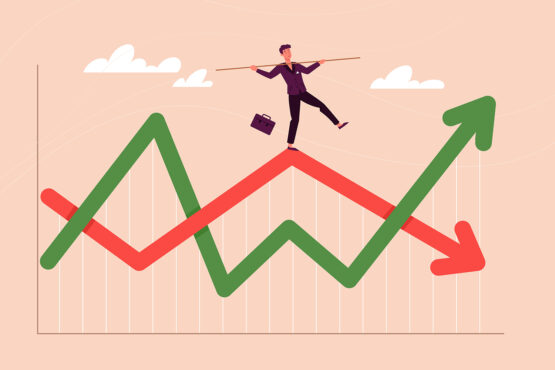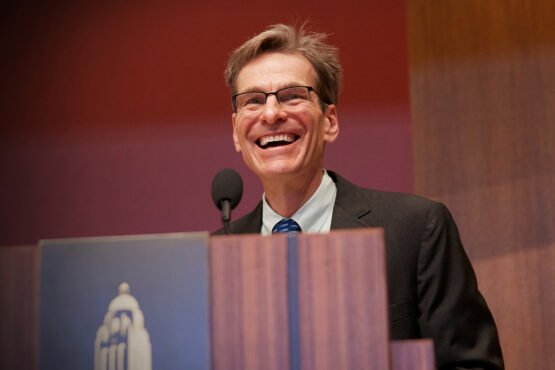Recessions are difficult, but stagnant growth could prove more challenging, Stanford economist warns
While recessions are difficult, they are temporary, says Stanford economist John Cochrane. What is more painful is long-term economic slowdown and stagnation.
While recessions are painful, they are only temporary interruptions to the economy, says John Cochrane, an economist at Stanford’s Hoover Institution, arguing that people should be paying more attention to long-term economic growth, which in the U.S. is currently stagnating.

In this Q&A, John Cochrane talks about recessions, the relationship between inflation and recession, stagflation – a recession with inflation, and the role the Federal Reserve (the Fed) plays in managing the health of the economy.
Here, Cochrane discusses what people, economists included, understand and don’t understand about recessions, what is over and underestimated about them, and why it’s important to look at the bigger picture. Rather than focus on quarterly changes to growth rate, which is how recessions are currently gauged, the long-run growth of the economy matters more.
Moreover, what causes recessions is not entirely clear and a topic of debate, Cochrane said. He also addresses the relationship between inflation and recession, stagflation – a recession with inflation, the role the Federal Reserve (the Fed) plays in managing the health of the economy, and what other factors people should look at to gauge that, such as a labor force participation, which is the number of people employed or actively seeking employment (instead of unemployment rates, which focuses on the number of people who are not employed and looking for work).
Cochrane specializes in financial economics and macroeconomics. He recently authored a book about inflation, The Fiscal Theory of the Price Level (Princeton University Press, 2022).
This interview has been edited for length and clarity.
Fears about a recession have loomed for months, years even. Why isn’t the U.S. in a recession yet?
One might say that fears about a recession have loomed for centuries! But like disease, fear of recession does not itself cause a recession.
What do people – economists included – understand and don’t understand about recessions?
We know they happen and seem to be a regular phenomenon. In some sense, recessions look much alike. Economic activity declines throughout the economy and all over the country, unlike, say, a bad snowstorm that affects only one area or a boom in one industry like tech. Durable goods, investment, housing, and things you borrow to finance, all get hurt much more; services and nondurable goods (food) fall much less. Employment falls, unemployment rises.
Recessions often happen when something bad happens – a financial crisis (1933, 2008), a large monetary or credit policy tightening, a disruption in oil markets (1973, 1979), or the moment we find out that a boom has run its course (1929, 1999). But those are often amplifying factors rather than complete causes, as those events sometimes don’t lead to recessions.
What causes recessions?
Just what causes recessions and drives these mechanisms is a bit contentious. The fact that every business falls at the same time leads to the Keynesian idea that “lack of demand” is at fault. But why should people wake up one day and just want to spend less? Why should that be the same everywhere in the country? The economy is surely more complex than a one-dimensional “stimulus” theory describes.
One cause of recession is the natural turbulence of some businesses expanding and others contracting. 2008 was a bit due to the fact that no, we aren’t all going to move to Las Vegas, so we need to stop building houses there. 1999 was in part the end of the first round of the internet. It seems pretty clear the end of this round of internet development is at hand, and as big bets on endless growth go bust, and as people move away from one kind of job to another, there can be at least a slowdown.
Even famous recessions in 2008 and 1929 show a decided slowing of economic activity before the financial panic. The financial panic is at least partly caused by the growth slowdown. Risky companies betting on years of continued growth are suddenly worth less, as we’re seeing right now in tech. If banks are overexposed to those businesses, that feedback can make matters worse.
What else do people often misunderstand about recessions?
People also misunderstand the nature of unemployment. Even in recessions, most people get jobs relatively quickly. The real issue is labor force participation, the declining number of people who are even looking for work, in good times and bad.
“Recessions” are when income is going down, and the unemployment rate is rising. But we are still in “bad times” when income is low and unemployment is high. That persists a good bit past a “recession.” I think if we could do it over again we’d define recessions in terms of low levels of GDP and high levels of unemployment, not growth rates.
The other thing most people get wrong is to dramatically overstate recessions, painful as they are, in the big scheme of things. A bad recession might lower income by 5% for a few years. But long-run growth overwhelms such changes. In 1950, average income was under $15,000 per year, in 2012 dollars. Now, it’s $60,000, in 2012 dollars. That’s huge.
Currently, stagnant growth is our big problem. Long-run growth of the economy matters much more than year-to-year growth rates. Recessions are painful interruptions, but we should be paying much more attention to long-run growth.
I asked John Taylor this a few months ago, and I’d be curious to get your take on it too: What is the relationship between inflation and recession? Why does the Fed have to aggressively raise interest rates to end inflation?
There is definitely a correlation between inflation and recessions. Inflation tends to ease in a recession, and accelerate in a boom. The Fed is counting on this effect, as inducing a bit of recession is its only tool right now. (Or inflation really comes from fiscal policy, and the Fed is being asked to counteract that.) But that’s not always and everywhere. Sometimes we have stagflation – a recession with inflation. That is much more common across the rest of the world than in the U.S. Countries in trouble – that often includes fiscal trouble for their governments – tend to have inflation in bad times, not just in good times. That mechanism could be coming to the U.S. soon.
Right now, the worry is that the Fed and other central banks, in their efforts to fight inflation, will tighten money and credit to the point that it causes a recession. That is, indeed, much of the point of the Fed’s actions. The standard story for how the Fed affects the economy is that the Fed slows the economy down, pushing it toward recession, and specifically slowing down parts of the economy that depend on cheap credit, and that this economic slowdown reduces inflation. The hope is that the Fed can add just enough recessionary force to offset inflation, but not so much as to actually see a recession. The fear is that it will overshoot.
But lots of other forces can go wrong. Rising interest rates cause a lot of financial trouble for businesses that, once again, have set themselves up hoping for perpetually free borrowing.
There are lots of other episodes in which inflation does go away on its own. In my view, we have a one-time inflation caused by the one-time fiscal blowout of the pandemic. If nothing bad happens, in particular no additional fiscal blowout, inflation will slowly ease without the Fed having to cause a recession like we saw in the early 1980s. If the U.S. returned to a strong supply-side growth policy, that would help too. But I may be wrong, and bad shocks could surely come.
Could there be any spillover effects if there is a recession elsewhere in the world, such as in the eurozone, the U.K., or China?
Yes. We live in a global economy, like it or not. China seems in danger [of recession], and surely there will be some spillover. Europe is in for a hard winter, and both energy problems and its government debt problems could cause trouble and spill over to the U.S.
Cochrane is the Rose-Marie and Jack Anderson Senior Fellow of the Hoover Institution at Stanford. He is a senior fellow of SIEPR and a professor of finance (by courtesy), and of economics (by courtesy) at the Graduate School of Business. He is also a research associate of the National Bureau of Economic Research and an adjunct scholar of the CATO Institute.

